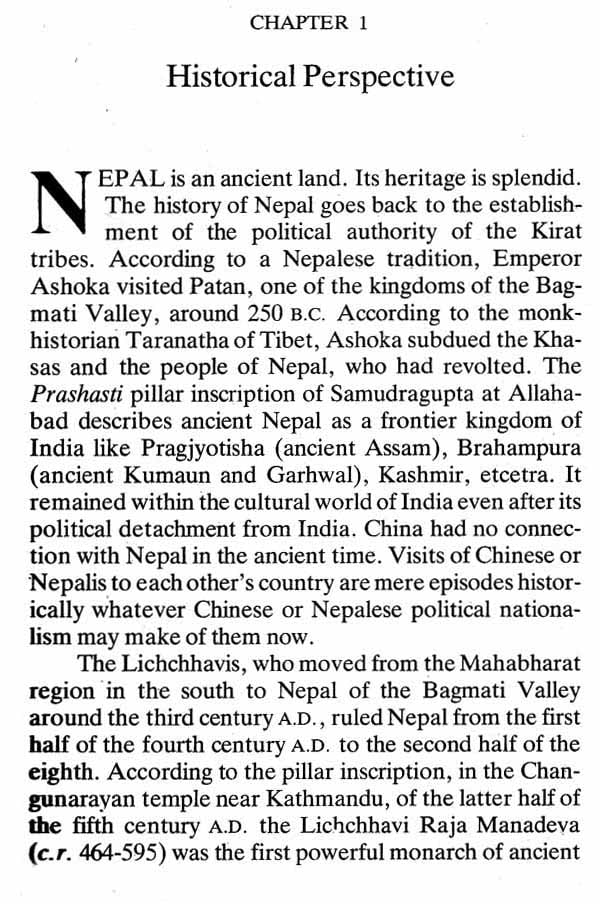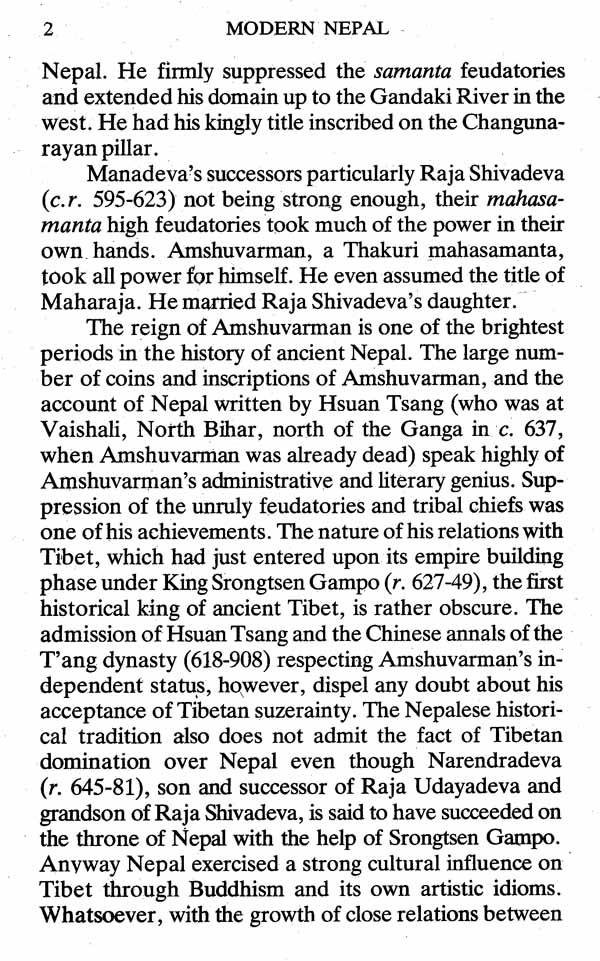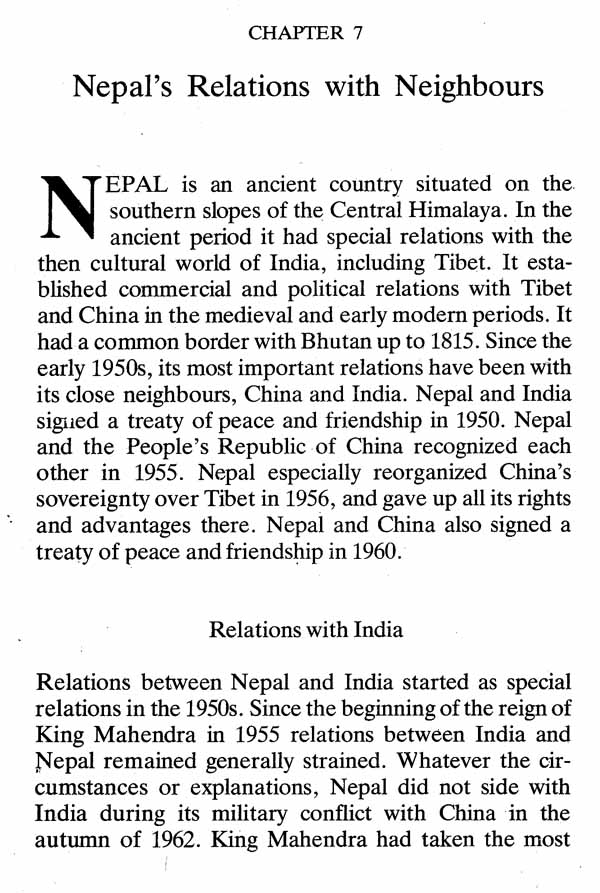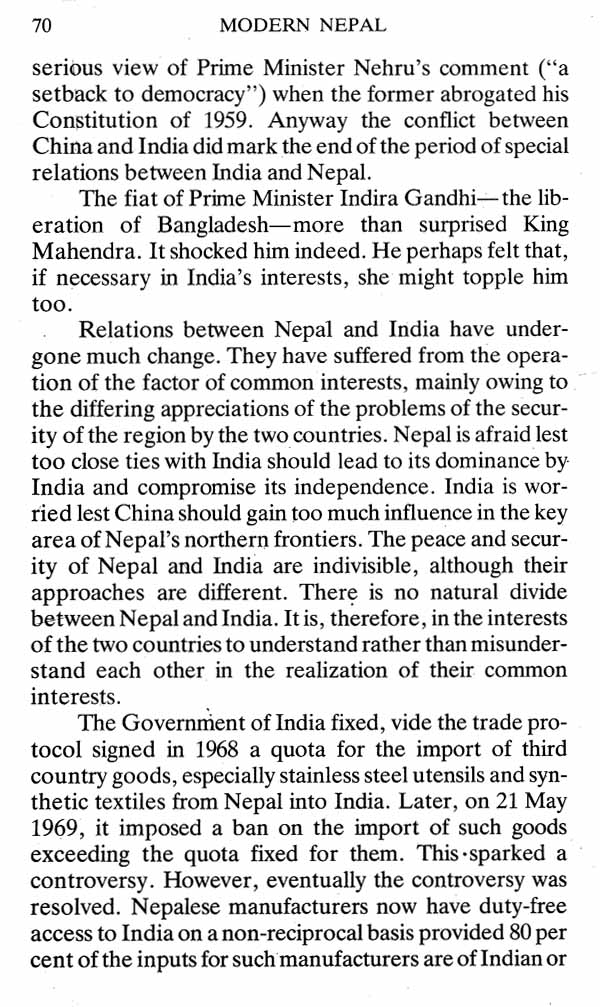
Modern Nepal (An Old and Rare Book)
Book Specification
| Item Code: | NAY655 |
| Author: | Ram Rahul |
| Publisher: | MUNSHIRAM MANOHARLAL PUBLISHERS PVT LTD |
| Language: | English |
| Edition: | 1985 |
| Pages: | 108 |
| Cover: | HARDCOVER |
| Other Details | 9.00 X 5.50 inch |
| Weight | 310 gm |
Book Description
Nepal is the ancient land of an ancient people. It lies on the southern slopes of the Central Himalaya, and adjoins China and India. Until the second half of the eighteenth century, or until the 1768-69 to be precise, the name "Nepal" denoted only the valley of the Bagmati River, where Kathmandu, the capital of present-day Nepal, is situated.
Professor Ram Rahul has long been studying Nepal. In Modern Nepal he deals with Nepal of the post-1769 period. He first surveys the history of Nepal up to 1769. Then he studies the period of the kings of the whole of Nepal to date. He also studies Nepalese Hinduism and Nepal’s relations with its neighbor especially China and India. He concludes the study with certain projections on the future of Nepal on the basis of its history and culture.
Professor Ram Rahul of the faculty of the School of International Studies, Jawaharlal Nehru University, New Delhi, is the eminent expert of Central Asia and the Himalaya borderlands. He has travelled extensively in the Himalaya, and continues to do so. He has also written extensively on the Himalaya borderlands, especially the kingdoms of Bhutan and Nepal. His interest is Asian relations, history and cultures including religions.
Nepal is the ancient land of an ancient people. It lies on the southern slopes of the Central Himalaya, and adjoins China and India. In ancient times, Nepal was one of the kingdoms of India's Himalaya frontiers like Pragjyotisha/Kamarupa (present-day Assam), Brahmapura (present-day Garhwal and Kumaun), Kuluta (present-day Kulu) and. Kashmir. However, until the second half of the eighteenth century, or until 1768-69 to be precise, the name "Nepal" denoted only the valley of the Bagmati River, where Kathmandu, the present capital of modern Nepal, is situated. The modern period of Nepal begins with the conquest of the kingdoms of the Bagmati Valley by Prithvinarayan Shah of Gorkha in 1768-69.
Modern Nepal deals with Nepal of the post 1769 period. Next I study the period of the kings of the whole of Nepal. Modern Nepal consists of three distinct periods, viz 1769-1846, 1846-1951 and 1951. I start with the survey of the history of Nepal up to 1769. The kings of Nepal both reigned and ruled absolutely in the first period, which was also a period of tremendous court intrigue. A certain family of the Thapa clan emerged to political power in Nepal after a bloody coup, known as the "Kot" massacre, in 1846. The Rana prime ministers enjoyed enormous powers. Indeed they can be said to have been de facto kings of Nepal in the second period from 1846 to 1951. The overthrow of the Rana oligarchy in 1951 resulted in the restoration of the monarchy to its original position of power and supremacy in Nepalese affairs. The kings of the third period from 1951 to date have ruled with the help of advisers, or democratically, or directly. Then I quickly survey Nepalese Hinduism which has had a great hearing on Nepalese history and culture. After this I study Nepal's relations with its neighbours especially China and India. I conclude the study with certain projections on the future of Nepal on the basis of its history and politics.
The Bibliography lists only certain works on Nepal in English and Nepali. I have omitted all works on Nepal published in languages which I do not use. The Appendices contain only select documents.
I dedicate this study to the fond memory of Dr S.N Mitter, who took care of my eyes and thereby enabled me to write my books. I must also make grateful mention here of the kind concern shown by Dr Hari Mohan for the health of my eyes. I thank the officials of the Royal Government of Nepal for their many courtesies. I am also thankful to Lt. Governor M.L. Kampani of the Andamans (Port Blair) and Vice-Chancellor D.B. Dutta of the University of North Bengal (Siliguri, District Darjeeling) for their gracious interest in this study on Nepal. My thanks are further due to S.S. Deora of the School of International Studies, Jawaharlal Nehru University, New Delhi, for his help in the preparation of the manuscript of this study.
**Contents and Sample Pages**












